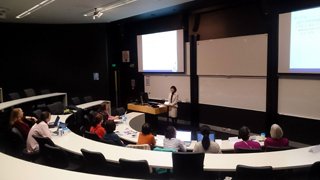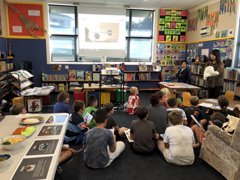Supporting Japanese-Language Education in New Zealand
New Zealand Ministry of Education
MIKAMI Kyoko
The Japanese-Language Specialists dispatched to New Zealand are assigned to organizations promoting foreign language education under consignment from the New Zealand Ministry of Education to serve as National Advisors for the Japanese language. I am currently assigned to Future Learning Solutions (hereinafter “FLS”), an organization under the UniServices, the administrative division of the University of Auckland. FLS itself is further divided into six divisions, and I serve as the Japanese-Language Chief Advisor (hereinafter “Advisor”) for one of those, the Language Education Team.
Other members on the FLS Language Education Team include the National Advisors for Chinese, Spanish, French, and German, and several Professional Experts in charge of teacher training programs. FLS also includes a manager in charge of the overall organization, as well as administrative staff members, and we all function as a team to promote foreign language education and provide support for teachers. While the duties of Advisors are wide ranging, the main ones are visiting schools and hosting workshops. Another important duty includes attending Japanese speech contests and other Japanese related events throughout the country and accompanying school visits carried out by the embassy and the consulate general.
Immersion Day
Photo 1 is from Immersion Day held in July 2018. Immersion Day was a workshop we held to allow teachers to be immersed in the language they teach for an entire day. To begin the day, we focused on Kanji as the theme and had the teachers review their basic knowledge through a quiz and try a card game, while also exchanging ideas and examples of Kanji learning in the classroom. This was followed by an introduction of famous “Japanese proverbs.” We discussed the Japanese lifestyles, the way Japanese people think, and cultural background that are in the backgrounds of proverbs while comparing these with the culture and lifestyles of New Zealand, which proved quite popular with the teachers.

Photo 1: The Japanese Immersion Day.
In the next session, we tried Japanese design of Kirigami, a type of Japanese craft to create pictures by cutting paper. While the teachers had all tried Origami numerous times, it was their first time to try Kirigami, so they became quite engrossed in creating various designs, such as themes from the Chinese zodiac and Japanese style accessories. This was followed by a Shodo (Japanese calligraphy) session. For the session, my friend who happens to be the only Grand Master of Calligraphy in New Zealand came all the way from the Nelson on the South Island to lead the session. The teachers were overjoyed to be instructed by a real master calligrapher as each of them had been teaching Shodo in their own style.
School Visits by the Consulate General
Photo 2 was taken when I accompanied the Consulate General of Japan in Auckland on a school visit. On this day, we visited a primary school in Tauranga, roughly two and a half hours by car from Auckland. We started by showing the children a video introducing both traditional Japanese culture and the latest technology. We then introduced Japanese cuisine using food samples, and had the children write “secret” letters using erasable ballpoint pens. However, the part of the visit the children enjoyed the most was a therapy robot called “Paro” shaped like a baby seal. Each child was allowed to hold and stroke Paro, to their great satisfaction. Other aspects of Japanese culture introduced on these school visits include wearing Yukata (traditional summer kimono)and Happi coats and playing traditional Japanese games such as Kendama (a toy with a ball and handle)and Karuta (playing cards), and I try my best to accompany as many of the visits as possible. My hope is that the children begin to take an interest in the Japanese language and culture through these visits and become motivated to go on to study Japanese.

Photo 2: Accompanying the Consulate General on a school visit.
New Zealand is a multi-ethnic country that welcomes many immigrants, but it is also said to be a monolingual country in which it is considered to be sufficient to speak only English. For that reason, progress in foreign language education has not proceeded as well as it could, and there has been a decline in the number of students of not only Japanese, but European languages as well. Despite this situation, there was a piece of good news this year. New Zealand Association of Japanese Language Teachers, which had been inactive until last year, was restarted primarily by younger teachers. Though there is a limit to what I can achieve as the only Advisor dispatched to New Zealand, and there is only about eight months left to my dispatch, I intend to continue supporting the teachers involved in Japanese-language education every day through the school visits and workshops.
- What We Do Top
- Arts and Cultural Exchange [Culture]
- Japanese-Language Education Overseas [Language]
- Japanese-Language Education Overseas [Language] Top
- Learn Japanese-language
- Teach Japanese-language
- Take Japanese-Language Test
- Know about Japanese-language education abroad
- The Japanese-Language Institute, Urawa
- The Japanese-Language Institute, Kansai
- Japanese-Language Programs for Foreign Specified Skilled Worker Candidates
- Japanese Language Education for Japanese Children Resident Overseas and for the Descendants of Migrants
- Archives
- Japanese Studies and Global Partnerships [Dialogue]
- JF digital collection
- Other Programs / Programs to Commemorate Exchange Year
- Awards and Prizes
- Publications
